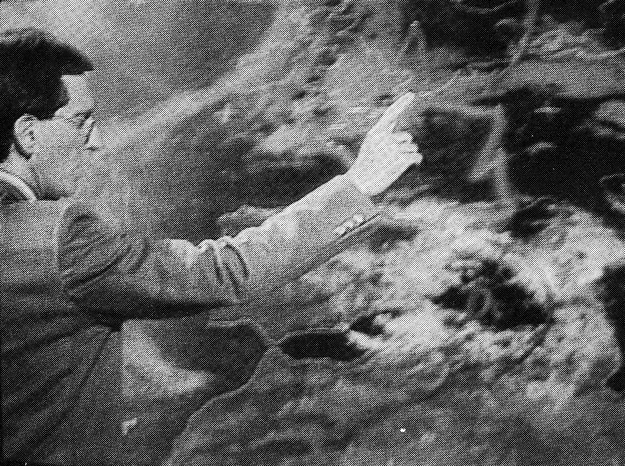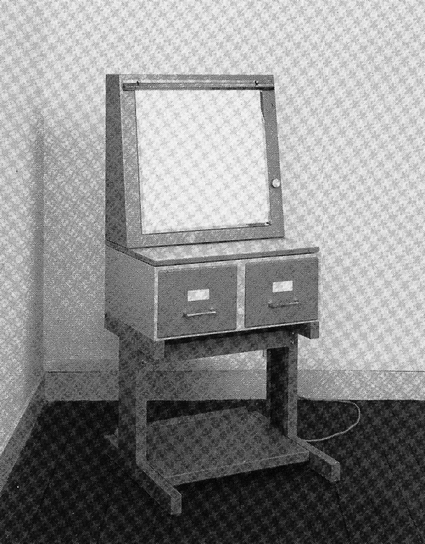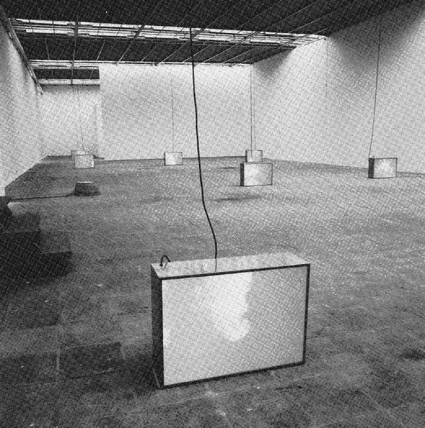The governing style of the descendents (who have names such as AEG and IBM) differs considerably from GOD's. It's striking that GOD invariably presented the heavens' visual signs as symbols of his power which were reinforced by such visual wonders as the sun's ceasing to turn and the discovery of the rainbow. By contrast, IBM apparently leaves the heavens alone. Its domain is established with noiseless and completely invisible electronics. It is only at night that here and there officially patented and registered logos light up as symbols of its power.
These two powers - those of GOD and IBM - parallel two distinct conceptions of art. An art that aus dem Bauch schöpft (comes from the guts) and an art that stems from the cerebral context. This aims at clarity and analysis. Only the latter can compete with the cool intelligence of the information society. One of its representatives is IFP.
Heaven
Two Parisian artists, JEAN-FRANÇOIS BRUN and DOMINIQUE PASQUALINI, are behind IFP (Information, Fiction, Publicité). They are both its directors and sole employees. IFP (founded in 1983) is an office that operates in the realm between art and philosophy, between art and industrial design, between fiction and reality, constantly circling and returning to the commutability of the countless images of mass society. The office's activities reach beyond the traditional boundaries of art. Hence, in the past IFP helped organize an extravagant fashion show or has arranged super market-like sales of books and records. In terms of exhibitions, the agency usually presents images from the media world, fiction and information, as art. This last aspect dominated IFP's first Dutch presentation - in DE APPEL in Amsterdam. It was a show with subtle reversals and simulacra. Here it was not the theatre or cinema - the place where it happens - that was depicted but the space left empty for the audience; it was not the large format ektachrome slide but the accompanying viewer; it was not a group of illuminated objects that was depicted but the light source itself, sunlight, the heavens; not an image of empathy but one completely designed in the style of the business class of an international airline. There is a window display on the floor with a constantly rotating disc bearing the IFP logo, a simulacrum in optima forma. It was poignant how disastrously the confrontation of these images ended with their presentation as real art.
The weatherman - Aluminium, fluorescent tubes, plexiglas, duratrans 81x125x13,5 cm.
The heavens are one of IFP's favourite themes. In the recently published retrospective catalogue I came across a work showing a TV weather-man who stands right slap against computer generated satellite images and is compelled to play the role of ruler and weather prophet in an apparently successful attempt to forge together the narrative, good, old-fashioned world of GOD with the expressly scientific world of the super-sonic and high-tech. All quite necessary, but essentially ludicrous and sad.
IFP manages to scorch both the back of GOD's robe and the paper thin skin of the age of information.
Ektascope - Enameled steel, plexiglas, fluorescent tubes 123x56x55 cm.
If you'd like to quote something: Meyerink, Gert. "GOD, IBM and IFP." Mediamatic Magazine vol. 3 # 1 (1988).
Translation: Annie Wright
